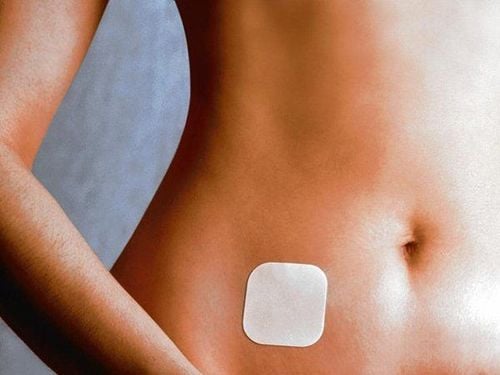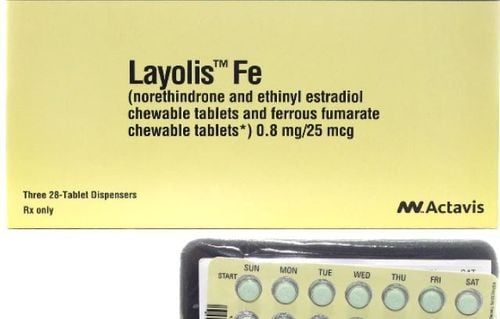This is an automatically translated article.
The article was professionally consulted by Specialist Doctor II Lai Thi Nguyet Hang - Department of Obstetrics and Gynecology - Vinmec Ha Long International General Hospital.The contraceptive patch is relatively safe, easy to use and, if used correctly, will give a high contraceptive efficiency, possibly over 95%. As long as you stop using the patch, ovulation will return after about 3 menstrual cycles.
1. What is the contraceptive patch?
It is a small patch, about 4.5cm thin, applied directly to the skin of the buttocks, abdomen, upper back or upper arms. The patch has the ability to release estrogen and progestin, hormones that are similar to the hormones produced by the body to prevent ovulation. The patch also helps thicken cervical mucus, making it difficult for the egg to contact sperm. The contraceptive patch, if used correctly, is highly effective, with a birth control rate of up to 95%. If you want to get pregnant again, simply stop using the patch and ovulation will return after about 3 menstrual cycles.Trắc nghiệm: Bạn có hiểu đúng về dấu hiệu mang thai sớm?
Các dấu hiệu mang thai sớm không phải chỉ mỗi trễ kinh mà còn có rất nhiều dấu hiệu khác như xuất huyết âm đạo, ngực căng tức,… Điểm xem bạn biết được bao nhiêu dấu hiệu mang thai sớm thông qua bài trắc nghiệm này nhé!
2. How to use the contraceptive patch
Carefully tear the condom of the patch along the edge of the condom, pull the patch off and peel off the layer applied to the patch so as not to touch the adhesive surface of the patch, then apply the patch to the skin. dry clean, hairless. Usually applied on the buttocks, abdomen, outer upper arm or upper body.Note that the contraceptive patch should not be applied to the breast, the skin area is red or irritated or scratched; Do not apply makeup, use creams, powders or other products on the skin that is applying the patch and the skin that is about to be patched to avoid reducing the adhesion of the contraceptive patch, reducing the effectiveness of contraception. pregnancy
The contraceptive patch is used in cycles of 4 weeks or 28 days. That is, within 3 weeks, the patch must be changed once a week. By the fourth week do not use the patch and menstruation will occur. After 4 weeks, apply a new contraceptive patch and repeat the same procedure as before. Note that the patch should not be removed during daily activities, such as bathing, swimming, exercising.

3. Advantages and disadvantages of the contraceptive patch
Pros May help improve acne and relieve menstrual migraines. Highly effective, easy to use, simple Can help, relieve symptoms for perimenopausal women Disadvantages May lead to some rare risks: blood clots in the legs, heart attack heart attack and stroke, gallstones and liver tumors. This risk is higher in some cases, such as women over 35, who smoke. Therefore, it is advisable to consult a doctor about the possible risks before applying. May cause nausea, headache, itchy skin or a red rash on the skin surface where the patch is applied.4. Contraindications of the contraceptive patch
Although the contraceptive patch is relatively safe, it can still cause rare risks such as blood vessel embolism, myocardial infarction, etc. Therefore, before using the contraceptive patch, it is necessary to examine and consult. at reputable medical facilities to know if they are in the group of contraindications or not.Cases of absolute contraindication Pregnant or suspected of being pregnant, breastfeeding within 6 weeks after giving birth At risk of cardiovascular diseases such as subjects aged 35 years or older, regular smokers Frequent, high blood pressure, diabetes Have been suffering from cardiovascular diseases such as blood clotting disorders, pulmonary embolism, venous thromboembolism, heart valve disease,... Having liver failure, cirrhosis, liver tumor Relative contraindications Use of some anticonvulsants such as phenytoin, carbamazepine, barbiturates, primidone, topiramate, oxcarbazepine, antiviral drugs, rifampicin antibiotic... Women who are breastfeeding after giving birth between 6 weeks and 6 months or women who do not breastfeed within 4 weeks of giving birth Have had breast cancer that has not returned within 5 years Dyslipidemia
5. Notes when using the contraceptive patch

Please dial HOTLINE for more information or register for an appointment HERE. Download MyVinmec app to make appointments faster and to manage your bookings easily.














